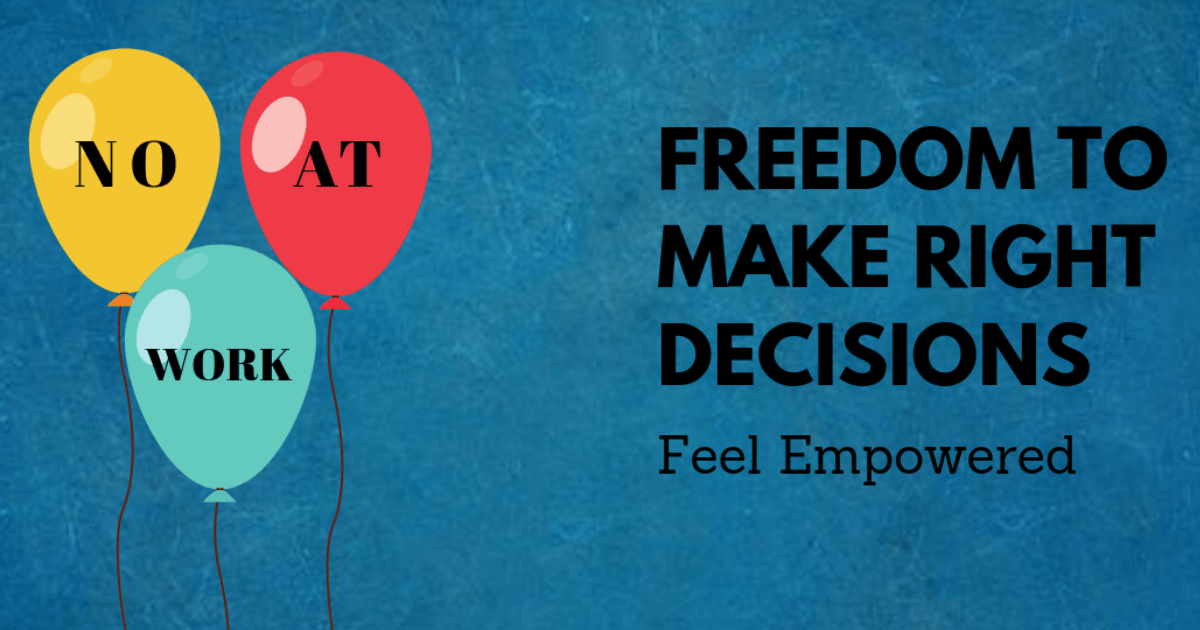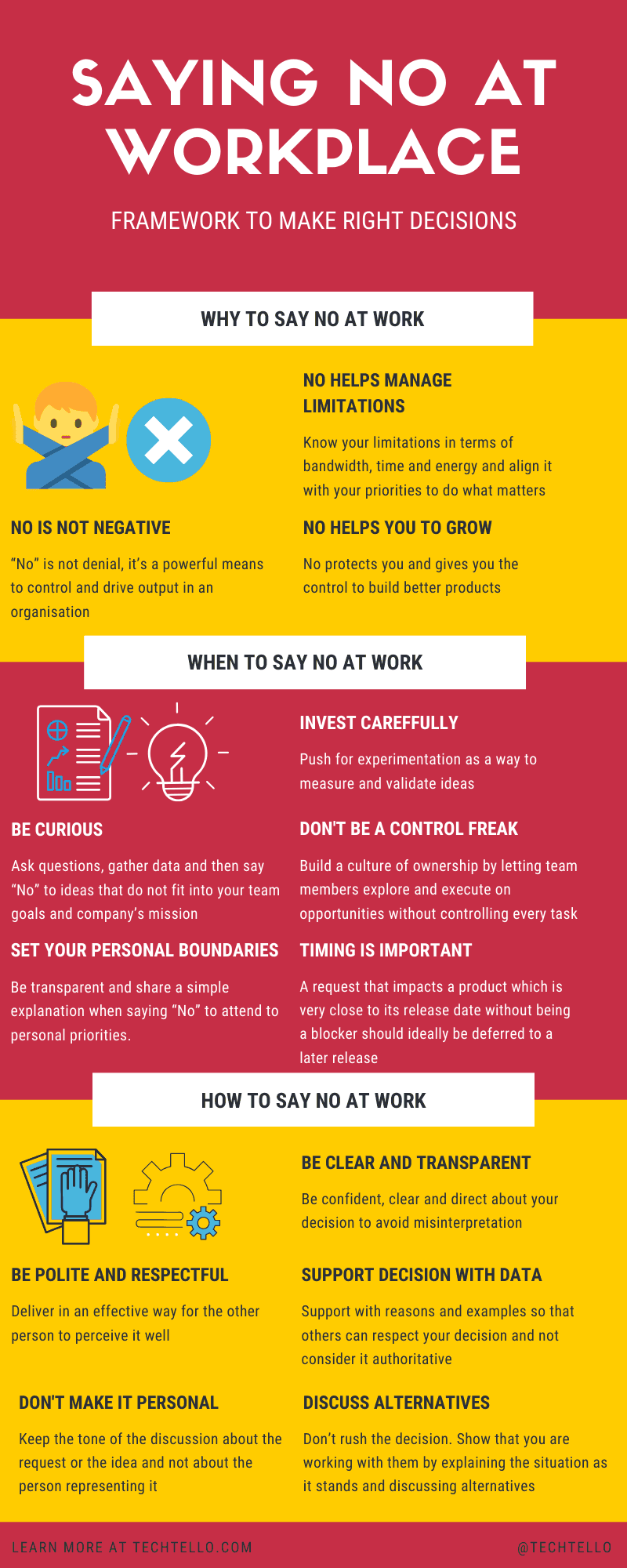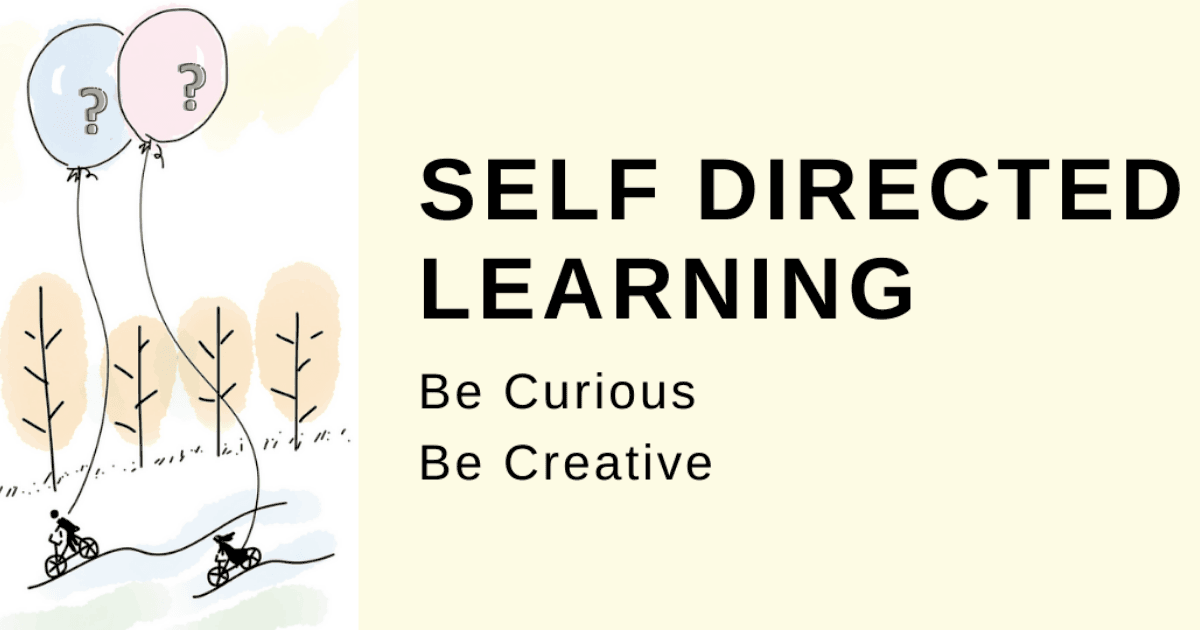Saying No at Workplace: Framework to Make Right Decisions
Saying no is a freedom rarely explored. As humans, we have an innate desire to hear yes to everything we feel important. A simple no without rational justification can make us untrustworthy and obstinate to the other person who reached out to us. In a workplace, some may even consider it a sign of weakness or incompetence as they attach their own interpretations to our response.
We say yes out of fear, desire to please others or simply because we are not aware of our own limitations. When we first accept, it may seem like a service to others, but along the way as we struggle to keep our original commitments, anxiety builds up. We wonder how we can manage it all, is there a way to go back on our decision even questioning why we accepted it in the first place.
Failing to deliver on our promises by not saying no at the right time can hurt others who were counting on us, shatter their trust and leave us feeling demotivated. Steve Jobs put this so succinctly “It’s only by saying NO that you can concentrate on the things that are really important.”
Saying no is crucial, but it also needs to be delivered right. Let’s learn why to say no, when to say no and how to say no.
Why to say no at work

We forget a very important aspect while dealing with others in the workplace – No one except us have a detailed view of all the things going on in our team and life. They may have a high level view of our team priorities (that too if they are in our direct line of work) but will always lack perspective on what the new idea or request will mean to us and our team. They look for our expertise to help them make the right decision. No one wants to make a bad decision, at least not intentionally.
It’s our job to question and understand every new request and idea coming our way and not follow orders even and especially if it’s coming from someone senior in the organisation. Feel empowered to ask so that the other person can explain, partner with them on the idea and then reach a decision. Feel vested and own the decision. It won’t matter if it turns out to be yes or no.
It’s occasionally possible to work with people who do not respect our decision, show anger or get upset when we reject their idea even though it’s the right thing to do. Be firm, do not stumble. Continue to do what is beneficial for your team and the company and do not make any changes to please others.
No is not negative
Since childhood our mind has been trained to think of no as rejection, a negative feeling, something that makes us bad. Without realising it makes people act and behave in a way that avoids conflict and please others. The desire to avoid confrontation makes us agree to decisions without realising their repercussions.
No is not denial, it’s not negative. It’s a powerful means to control and drive output in an organisation. Avoiding the short-term argument that no can create will prevent you from doing the right thing for your team and your company.
No helps manage limitations
It starts with understanding your priorities and taking control of it. Be aware of the long term goals and how your day-to-day work fits into it. Know your limitations in terms of bandwidth, time and energy and align it with your priorities to do what matters.
Think of it as a framework when presented with a new request to identify how it fits into the bigger picture and does it push beyond your limitation to make the right decision.
Having a framework to manage your limitations will prevent the discussion from getting personal and push for an effective no.
No helps you to grow
No helps you to focus on things that matter. With more requests than you can fulfil, doing the right thing at the right time is important for the success of your team and organisation. No protects you and gives you the control to build better products.
When others see the positive results of your thoughtful “No”, they will trust you with more complex decisions in future.
In his book The 7 Habits Of Highly Effective People, Stephen R. Covey stated
You have to decide what your highest priorities are and have the courage pleasantly, smilingly, and non apologetically – to say “no” to other things. And the way to do that is by having a bigger yes burning inside
When to say no at work

A carefully crafted no after proper consideration and evaluation goes a long way in establishing trust and creating a healthy and safe environment where doing right is valued more than simply doing more.
Be Curious
Do not shut down an idea or a request with an impulsive desire to control project timelines. Show active curiosity and understand it first. Ask questions, gather data and then say no to ideas that do not fit into your team goals and company’s mission.
Use your judgement and not your authority to determine if the request must be considered or deferred or rejected even though it may impact your schedule.
No backed by data and strong line of reasoning after carefully considering the request will encourage freedom of ideas and establish credibility.
Timing is important
While every request may come as an urgent or important change, it’s your responsibility to do cost-benefit analysis and then take a decision.
A request that impacts a product which is very close to its release date without being a blocker should ideally be deferred to a later release. In general, it’s a good practice to maintain an active backlog of all such requests and revisit them after the first release along with feedback from the release to prioritise coherently.
Don’t be a control freak
While it’s good to have goals for every team member and tasks that line up with those goals, it should not be set in a manner that limits teams freedom to explore and improve. If a team member identifies a change that benefits a large part of the team (e.g. automation, bug) and wants to fix it, be supportive and determine ways to accommodate it.
Build a culture of ownership by letting team members explore and execute on opportunities without controlling every task.
Invest carefully
Say no to investment in building a full fledged product when requirements are not fully thought through or lack important data to make sound decisions.
Push for experimentation as a way to measure and validate ideas. Value your team’s time and invest in products with measurable outcomes.
Set your personal boundaries
You like going home in time to put your child to bed or have a PTM to attend or other family priorities, be candid and say no to requests that conflict with your personal schedule.
Staying in office and compromising on your personal goals can not only lead to stress, but can also be unproductive at work. Be transparent and share a simple explanation when saying no to attend to personal priorities.
How to say no at work

Learn to say no in a manner that’s well received by the other person, makes them understand your reasoning without taking it personally.
Be polite and respectful
While saying no is important, it must be delivered in an effective way for the other person to perceive it well. Being watchful of your body language and tone is important to appear supportive even when you may be disagreeing with the other person.
Don’t make it personal
Keep the tone of the discussion about the request or the idea and not about the person representing it. It should not be an unpleasant experience that seems like a personal attack to the other person. There’s a huge difference between saying “Your idea is bad” vs “This idea does not take into account these X factors and hence cannot be considered”.
Be respectful of others thoughts by actively listening to them and not outrightly rejecting their idea. Ask the right questions to understand their viewpoint and keep the discussion productive.
Be clear and transparent
Be confident, clear and direct about your decision to avoid misinterpretation. Do not say maybe or later or I will consider when you know the answer is no.
This will save time as the message will be delivered loud and clear and will not leave room for interpretation and for the other person to consider the possibility of a change.
Support decision with data
Do not simply say no without justifying your decision and corroborating it with valid data points. Saying “I know this because I have experience in this area or I have done this before or you need to trust me” is not sufficient as it doesn’t help the other person understand your decision.
Support with reasons and examples so that others can respect your decision and not consider it authoritative.
Discuss alternatives
It’s not a sign of weakness to ask for help in making the right decision. If the request coming your way sounds valid and crucial to the project, but your current priorities and bandwidth prevents you from accepting it, say so.
Don’t rush the decision. Show that you are working with them by explaining the situation as it stands and discussing alternatives. Consider the impact of accommodating this request and ask for help to align on priorities.
Recommended Reading
JOIN MY NEWSLETTER
Saying no at workplace examples
The way we respond and put forth our viewpoint makes a big difference in how others perceive and react to it. Intention is not enough to drive right decision making within an organisation. We need to have the skills to decide “When to say No” and “How to say No”.
Let’s take an example and consider this conversation between 2 people:
Engineer: I have identified a few areas in our architecture that needs focus to achieve long term stability and scalability
Manager: We just locked down the quarterly roadmap. These items should have been included as part of planning
Engineer: Yes, we missed them. But they are important in the long term
Manager: Lets review them in our next quarterly meeting
Engineer: I don’t think we should push to next quarter
Manager: We have just locked down our roadmap and I need everyone to focus on the committed plan
This conversation is authoritative. It leaves the engineer feeling that the manager is arrogant and doesn’t care about doing what’s right for the team. It makes team members feel unmotivated and not committed to their goals.
Now, consider the same conversation where the manager is more receptive.
Engineer: I have identified a few areas in our architecture that needs focus to achieve long term stability and scalability
Manager: We just locked down the quarterly roadmap. How did we miss these items?
Engineer: We overlooked a part of the architecture and it may potentially cause many issues later
Manager: Ok. Lets review together
Second conversation gives the manager a chance to review changes suggested by their team and then make a decision. It’s possible for the manager to review and then push all the changes to the next quarter. However, the simple act of reviewing it with the team and making a collective decision keeps team members aligned on their goals.
It also gives the manager a chance to identify and provide feedback on how the team could have included them as part of the planning phase itself. Team feels happy about their manager being open and actively listening to them.
While both the conversations may have the same end goals (no changes to the original plan), the approach to reach the decision and how “No” is formulated makes a big difference in team morale and outcome.
Saying no is difficult for all of us in the beginning, but it’s essential to our growth and success.






























